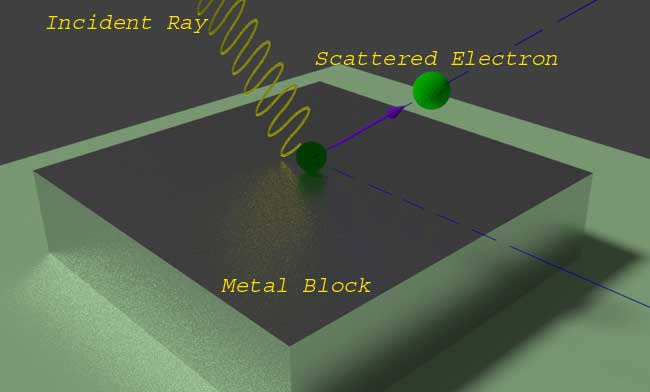Photo Electrons
October 26, 2020 by Electrical4U

When light strikes a clean material’s surface, electrons are emitted from that surface under some specific conditions. This phenomenon is well known as the photoelectric effect. The electrons are called photo-electrons. When light strikes on the surface electrons of the material gain sufficient energy from light to overcome the work function of the material and hence emitted from the surface.
当光线照射到清洁材料的表面时,在某些特定条件下,电子从该表面发射。这种现象被称为光电效应。这些电子称为光电子。当光照射表面时,材料的电子从光中获得足够的能量,以克服材料的功函数,并因此从表面发射。
What is Work Function?
It is defined as the minimum energy required to remove an electron from its shell (outer most shell of the atom). It is measured in eV (Electron-volt). According to classical physics the number of emitted electrons and their momentum is independent of the frequency at which the light strikes the material, but it depends upon the intensity of the incident light energy.
But in actual experiment this statement of classical physics could not be observed. Instead, it is observed that for a particular incident light intensity, the kinetic energy of the emitted electrons varies with the variation of the frequency of the incident light. That means if the frequency of incident light is changed without changing its intensity, then the kinetic energy of emitted electrons or photo-electrons also changes.
什么是功函数?
它被定义为将电子从其壳层(原子最外层)移除所需的最小能量。其测量单位为电子伏特。根据经典物理学,发射电子的数量及其动量与光照射材料的频率无关,但取决于入射光能的强度。
但在实际实验中,经典物理的这一说法无法被观察到。相反,观察到对于特定入射光强度,发射电子的动能随入射光频率的变化而变化。这意味着,如果入射光的频率在不改变其强度的情况下改变,则发射电子或光电电子的动能也会改变。
What are Photo Electrons?
When light energy of sufficient intensity strikes on a surface of material, some electrons of the material very close to the surface, gain sufficient energy to overcome the work function of the material and are emitted from the surface with kinetic energy. These emitted electrons are called photo-electrons. It is also observed that, above a certain frequency of the incident light, the electrons better to say photo-electrons start emitting. This is the minimum frequency of incident light below which no photo-electrons is produced.
But above this minimum frequency, the kinetic energy of the electrons varies linearly with frequency. It is also observed that when intensity of incident light is changed by keeping its frequency constant, the rate of photo-electrons emission changes accordingly but the maximum kinetic energy of electrons remains unchanged. In 1900, German Physicists Max Karl Ernst Ludwig Planck stated that the heat radiation from a hot body surface is in the form of discrete packet of energy and these packets of energy are called quanta. This quantity of energy consisting in a single quanta or emitted packet of energy is hf where f is the frequency of radiation and h is the constant called Planck constant that is the quantity of energy,
什么是光电?
当足够强度的光能照射到材料表面时,材料中非常靠近表面的一些电子获得足够的能量以克服材料的功函数,并以动能从表面发射。这些发射的电子称为光电子。还观察到,在入射光的特定频率以上,电子(更好地说,光电电子)开始发射。这是入射光的最小频率,低于该频率时不产生光电子。
但在该最小频率以上,电子的动能随频率线性变化。还观察到,当入射光的强度通过保持其频率恒定而改变时,光电发射速率相应改变,但电子的最大动能保持不变。1900年,德国物理学家马克斯·卡尔·恩斯特·路德维希·普朗克(Max Karl Ernst Ludwig Planck)指出,热物体表面的热辐射以离散的能量包的形式存在,这些能量包被称为量子。包含在单个量子或发射的能量包中的能量量是hf,其中f是辐射频率,


Quantum energy is proportional to the frequency of radiation. The value of Planck constant is
量子能量与辐射频率成正比。普朗克常数的值为:

In 1905 another famous German physicist Sir Albert Einstein stated that the light also consists of energy packet and this packets were referred as photons. The energy content in the photon is also given by same equation and that is
E = hf or E proportional to f.
Only difference is that here the frequency is the frequency of light.
1905年,另一位著名的德国物理学家阿尔伯特·爱因斯坦爵士(Sir Albert Einstein)指出,光也由能量包组成,这些能量包被称为光子。光子中的能量含量也由相同的方程给出,即
E=hf或与f成比例的E。
唯一的区别是这里的频率是光的频率。
As per this theory, when a light strikes on a material surface, photons with sufficient energy (when frequency is sufficient as E proportional to frequency) knock electrons on the surface of the material. The electrons gain sufficient energy to be removed from the surface, after overcoming the work function of the material. The rest of the energy in a photon is consumed to gain the kinetic energy of the electron. The maximum kinetic energy of an electron can be represented as
根据这一理论,当光线照射到材料表面时,具有足够能量的光子(当频率与频率成正比时)将电子撞击到材料表面。在克服材料的功函数后,电子获得足够的能量从表面移除。光子中的剩余能量被消耗以获得电子的动能。电子的最大动能可以表示为:

Where, hf0 is the work function or minimum energy required to remove the electron. h0 is the minimum frequency of incident light below which no electron is removed from the surface.
The photons energy or energy consisting in a photon of a particular light is proportional to the frequency of that light and hence that is inversely proportional to the wavelength of the light wave
其中,hf0是去除电子所需的功函数或最小能量。h0是入射光的最小频率,低于该频率,没有电子从表面移除。
光子能量或由特定光的光子组成的能量与该光的频率成正比,因此与光波的波长成反比
